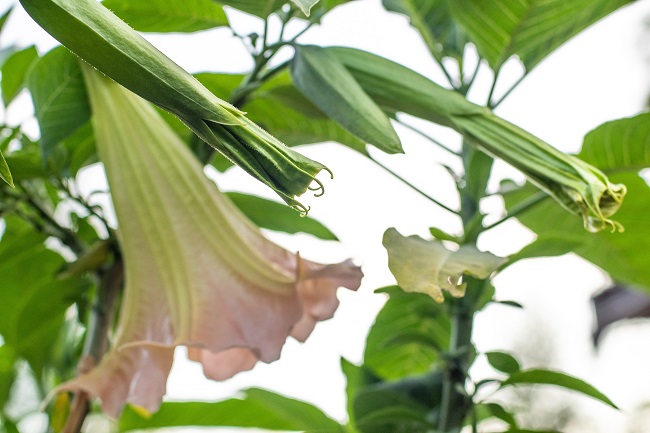
Brugmansia, commonly known as “angel’s trumpet,” is a fascinating and exotic plant with several fun and intriguing facts:
Ethereal Fragrance: Brugmansia flowers are renowned for their enchanting fragrance, especially in the evening. The scent is often described as sweet and intense, sometimes resembling a combination of jasmine, gardenia, and citrus notes.
Native to South America: Brugmansia is native to South America, particularly the Andes region, including countries like Ecuador, Colombia, and Peru. In its natural habitat, it can grow as a small tree up to 30 feet tall.
Toxicity: All parts of the Brugmansia plant contain alkaloids, which can be toxic if ingested. It’s essential to handle these plants with care and keep them out of reach of pets and children.
Hallucinogenic Properties: Some indigenous cultures in South America have used Brugmansia in shamanic rituals and for its hallucinogenic properties. However, these uses are extremely dangerous and not recommended due to the plant’s toxicity.
Unique Flower Shapes: Brugmansia flowers come in various colors, including white, pink, yellow, and orange, and they feature distinctive trumpet-shaped blooms that can grow up to 20 inches long.
Day and Night Blooms: Brugmansia flowers exhibit a fascinating behavior where they typically bloom in the evening and remain open throughout the night, emitting their captivating fragrance to attract pollinators like moths and bats.
Over 100 Cultivated Hybrids: Horticultural enthusiasts have created over 100 different Brugmansia hybrids, each with its unique flower colors and forms, making them a favorite among gardeners looking to add a touch of tropical elegance to their gardens.
Rapid Growth: Brugmansia plants are known for their rapid growth during the growing season. Under optimal conditions, they can grow several feet in a single year.
Popular Garden Ornament: Brugmansia’s stunning appearance and fragrance make it a popular choice for gardens and greenhouses in regions where it can be grown. It adds a touch of exotic beauty and drama to any landscape.
Vulnerable to Cold Temperatures: Brugmansia is highly sensitive to cold temperatures and cannot tolerate frost. In cooler climates, it’s typically grown in containers and brought indoors during the winter to protect it from freezing temperatures.
Pruning and Shaping: Due to its vigorous growth, Brugmansia often requires regular pruning and shaping to maintain a desirable form and size. This process can be a creative endeavor for gardeners.
Conservation Efforts: Some Brugmansia species are considered endangered or threatened in the wild due to habitat loss and deforestation. Conservation efforts are underway to protect and preserve these unique plants in their natural environment.
These fun facts highlight the beauty and intrigue surrounding Brugmansia, making it a captivating addition to gardens and greenhouses for those who appreciate its unique qualities and are willing to provide the proper care and attention it deserves.
Related Articles & Free Email Newsletter Sign Up
How to Grow African Violets in a Greenhouse
How to Grow Begonias in a Greenhouse



Comment here